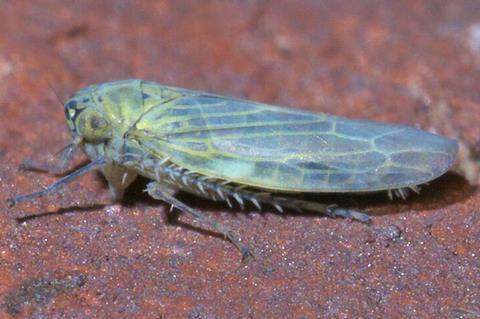Scientists have revealed a parasite’s role in boosting male insect appeal by modulating host processes to facilitate female attraction, thereby enhancing the parasite’s own transmission and survival.

The study, published as a Reviewed Preprint in eLife, is described by the editors as highlighting an important discovery: a bacterial pathogen’s effector influences plant responses that in turn affect how the leafhopper insect carrier of the bacteria is attracted to the plants in a sex-dependent manner. They add that the research is backed by convincing analyses and sheds light on previously unexplored aspects of plant–bacteria–insect interactions.
Parasites – which rely on hosts for survival and propagation – have substantial control over their hosts, earning them the nickname ‘puppet masters’. This is especially the case for obligate parasites that rely on alternate hosts (vectors) for transmission. Phytoplasmas, parasites that cause disease in crops and other plants, are reliant on sap-feeding insects, such as leafhoppers, for transmission. They attract these vectors by triggering the growth of unusual plant structures and clustering of leaves through effector molecules, such as the virulence protein SAP54. However, the mechanisms underlying this process are largely unknown.
Leaf-like flowers
“Our research focuses on the virulence protein SAP54, produced by phytoplasmas, which is known to induce the formation of leaf-like flowers in infected plants,” says lead author Zigmunds Orlovskis, a former postdoctoral scientist at the Department of Crop Genetics, John Innes Centre, Norwich, UK, and currently an independent project leader at Latvian Biomedical research and Study Centre. “Previously, we have demonstrated that leafhoppers are attracted to the leaves of infected plants, but this does not always depend on the presence of leaf-like flowers, so the exact mechanism is unclear.”
READ MORE: Bacterial hijack mechanisms as advanced genetic tools
READ MORE: Plant prebiotics offer new ally in the fight against pathogens
The team hypothesised that leafhopper attraction is influenced by proteins called MADS-box transcription factors (MTFs) that are involved in additional processes other than flowering, and this is what they set out to test.
They began by assessing the effect of SAP54 on male and female leafhoppers using choice tests – the insects were given the choice to feed and lay eggs on transgenic plants with and without SAP54. The team found that the leafhoppers produced more offspring on SAP54 plants than on those without. However, to their surprise, in the absence of male leafhoppers – there was no increase in offspring on the SAP54 plants. Similar results were seen with feeding preferences; the females secreted more honeydew (an indicator of feeding) on SAP54 plants in the presence of males and no obvious increase in honeydew when males were not present. Together, these results suggest that the attraction of female, fertile leafhoppers to SAP54 plants relies on the presence of male leafhoppers.
Signals behind the preferences
Next, the team focused on determining the signals behind these preferences. There were no differences in female leafhopper behaviours when they were placed in odour- and sound-proof containers, suggesting that the females are not using sound and smell for making their choices. This meant there must be some unique characteristic of the leaves in SAP54 plants that was attracting the females.
To explore this further, the team determined which genes were switching on and off in leaves of plants without and without SAP54 that were exposed to male and female leafhoppers. They found that SAP54 plants displayed a dramatically altered pattern of gene activity specifically when colonised by male leafhoppers, compared with the presence of female leafhoppers. Moreover, most of the genes belonged to cell defence and biotic stress pathways, and their activity was significantly lowered in the presence of the male leafhoppers. This could explain the female preference for plants with males already present.
To address their original hypothesis that MTFs were involved in the leafhopper preferences, the team repeated the leafhopper choice tests in plants with mutated versions of different MTFs. They found that female preference for male-exposed SAP54 plants was dependent on a specific MTF protein called SHORT VEGETATIVE PHASE (SVP). Moreover, plants lacking SVP respond to male and female leafhoppers differently, suggesting that SVP influences the leaf’s response to herbivores in a way that is partly specific to the gender of the leafhoppers.
Biotic stress response pathways
“We found that SAP54 suppresses the plant’s biotic stress response pathways when exposed to male leafhoppers. This suppression is crucial in enhancing the plant’s attractiveness to female leafhoppers - the plants producing the phytoplasma effector SAP54 effectively act like a matchmaking service by drawing females to the males,” says Orlovskis. “The findings also suggest that the phytoplasma virulence factor improves male fitness”.
“Our research underscores the dual role of the phytoplasma effector SAP54 in altering host development and enhancing plant attractiveness to reproductive females in the presence of male insects,” concludes senior author Saskia Hogenhout, Professor and Group Leader in Advancing Plant Health, John Innes Centre.
“This matchmaking effect is integral to the phytoplasma life cycle, because females lay eggs on the leaves and the leafhopper nymphs hatching from the eggs will feed from the plant, thereby acquiring the phytoplasmas that these insects may then vector to other plants. This finding provides profound insights into the extended reach of a single parasite gene in influencing host biology and vector behaviour.”







No comments yet